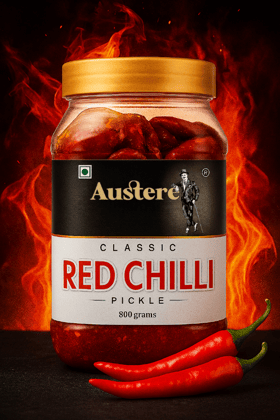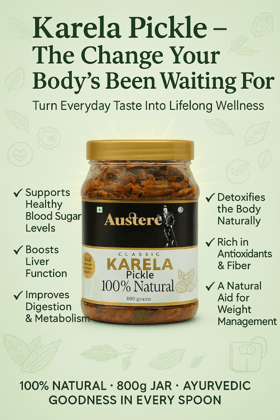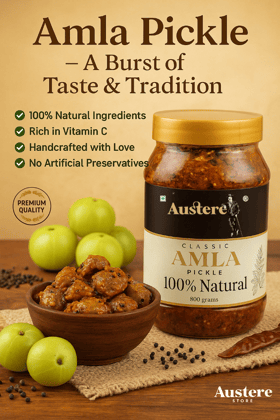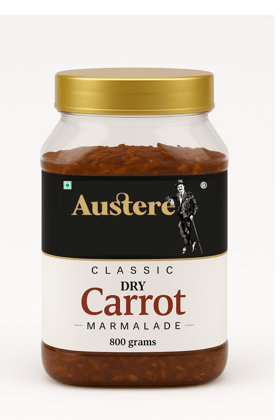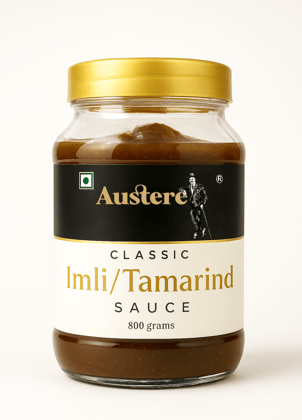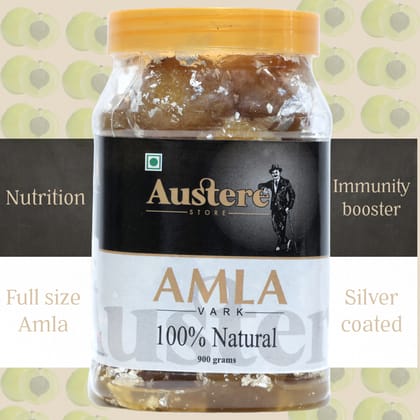- Bitter Gourd (Karela): Fresh bitter gourds are washed, deseeded, and sliced.
- Salt: Salt is used to reduce the bitterness of the gourd and is a crucial element in the pickling process.
KARELA PICKLE/ ORGANIC/ TASTY AND HEALTHY
Veg
Key Attributes
| Country of origin | India |
|---|---|
| Brand | AUSTERE STORE |
| Net Quantity | 800 gram |
| Product Dimensions | 12L x 12W x 12H cm |
- Bitter Gourd (Karela): Fresh bitter gourds are washed, deseeded, and sliced.
- Salt: Salt is used to reduce the bitterness of the gourd and is a crucial element in the pickling process.
- Spices: Common spices include mustard seeds, fenugreek seeds, turmeric, red chili powder, asafoetida (hing), and sometimes nigella seeds (kalonji).
- Oil: Mustard oil is often used for its distinctive flavor, but other cooking oils can also be used.
- Spicy: The combination of spices adds a spicy kick to the pickle.
- Tangy: Some recipes may include tangy ingredients like amchoor (dried mango powder) to balance the bitterness.
- Aromatic: Mustard oil and aromatic spices contribute to the overall aroma of the pickle.
Culinary Uses:
- Side Dish: Karela pickle is commonly served as a side dish with rice, dal, or Indian bread like roti or paratha.
- Condiment: It can be used as a condiment to add flavor to various dishes.
- Accompaniment: Karela pickle pairs well with yogurt, providing a contrasting flavor.
Health Benefits:
- Bitter Gourd Properties: Bitter gourd is known for its potential health benefits, including blood sugar regulation and digestive aid.
- Vitamins and Minerals: Bitter gourd is rich in vitamins and minerals, contributing to the nutritional content of the pickle
| Country of origin | India |
|---|---|
| Brand | AUSTERE STORE |
| Net Quantity | 800 gram |
| Additive info | Preservatives: Sodium Benzoate: Sodium benzoate is a common preservative used to inhibit the growth of microorganisms and extend the shelf life of the pickle. Acidity Regulators: Citric Acid: Citric acid is a natural acid found in citrus fruits and is used as an acidity regulator. It can contribute to the tanginess of the pickle. Coloring Agents: Natural Colors or Artificial Colors: While natural colors from Karela and other ingredients are often sufficient, some products might use additional natural or artificial colors to enhance or standardize the appearance. Flavor Enhancers: Natural or Artificial Flavors: Flavor enhancers may be used to enhance the overall taste and aroma of the pickle. Emulsifiers or Stabilizers: Pectin: Pectin is a natural thickening agent found in fruits. It may be added to improve the texture and consistency of the pickle. Antioxidants: Ascorbic Acid (Vitamin C): Ascorbic acid may be added as an antioxidant to prevent oxidation and maintain the color and freshness of the pickle. Sweeteners: Additional Sugar or Sweeteners: Some recipes may include additional sugar or sweeteners to enhance the sweetness of the pickle. |
| Batch number | A4 |
| Expiry Date | 10 MONTHS |
| Weight | 850 g |
| Package Dimension | 12L x 12W x 12H cm |
| Product Dimensions | 12L x 12W x 12H cm |
| Food type | veg |
| Ingredients | -Karela Pickle Ingredients:Fresh Karela (Bitter Gourd): -Washed and thinly sliced. Remove seeds if desired. -Salt:To sprinkle on Karela slices. Helps reduce bitterness. -Turmeric Powder:Adds color and mild flavor. -Mustard Seeds:Adds a distinct flavor to the pickle. -Fenugreek Seeds:Provides a slightly bitter taste and enhances the overall flavor. -Red Chili Powder:Adjust the quantity based on your spice preference. Adds heat to the pickle. -Asafoetida (Hing):A resin with a strong, pungent aroma. Used in small quantities to enhance flavor. -Mustard Oil:Mustard oil is commonly used, but you can use any cooking oil. The oil adds richness and acts as a preservative. -Mustard Seeds for Tempering (Optional):Used for the tempering process to enhance the flavor. |
| Nutritional information | -Calories -Carbohydrates: -Total Carbohydrates: Around 2 to 4 grams per serving. -Protein:The protein content can vary but is generally minimal, usually around 0.5 to 1 gram per serving. -Fat:The fat content is typically low, often less than 1 gram per serving. -Vitamins:Karela is rich in various vitamins, including vitamin C, vitamin A, and vitamin K. The pickling process may retain some of these vitamins. -Minerals:Karela contains minerals such as potassium, iron, and calcium. The mineral content of the pickle can depend on the ingredients used. -Antioxidants:Karela is known for its antioxidant properties, which may be retained in the pickle. Antioxidants help neutralize free radicals in the body. -Key Considerations:Added Salt and Oil: The sodium content in the pickle can vary based on the amount of salt added. Additionally, the use of oil in the pickle can contribute to the overall calorie |
| Instructions | Karela Pickle Instructions: Ingredients: Fresh Karela (Bitter Gourd): Washed, thinly sliced, and seeds removed. Salt: To sprinkle on Karela slices. Turmeric Powder: Adds color and mild flavor. Mustard Seeds: Adds a distinct flavor to the pickle. Fenugreek Seeds: Provides a slightly bitter taste and enhances flavor. Red Chili Powder: Adjust the quantity based on your spice preference. Asafoetida (Hing): A resin with a strong, pungent aroma. Mustard Oil: Commonly used, but you can use any cooking oil. Mustard Seeds for Tempering (Optional): Used for the tempering process. Curry Leaves (Optional): Adds a fragrant aroma to the pickle. Green Chilies (Optional): Sliced or chopped for additional heat and flavor. Instructions: Prepare Karela: Wash the Karela thoroughly and thinly slice them. Remove the seeds if desired. Sprinkle salt on the slices and let them sit for a while. This helps reduce bitterness. After some time, rinse the Karela slices under running water and pat them dry. Dry Karela: Allow the rinsed Karela slices to air-dry or use a kitchen towel to absorb excess moisture. Prepare Spice Mix: In a bowl, mix mustard seeds, fenugreek seeds, turmeric powder, red chili powder, asafoetida, and salt. Coat Karela: Coat the Karela slices with the spice mix. Ensure that the slices are well coated. Heat Oil: Heat mustard oil or any cooking oil in a pan until it reaches its smoking point. Allow it to cool slightly. Tempering (Optional): In a separate pan, heat a small amount of oil, add mustard seeds, curry leaves, and green chilies. Allow them to splutter. Combine Ingredients: Pour the tempered oil mixture over the Karela slices. Mix well to ensure the spices and oil are evenly distributed. Cooling Period: Allow the Karela pickle to cool to room temperature. Transfer to Jar: Transfer the pickle to a sterilized glass jar. Ensure the jar is airtight. Maturation Period: Allow the pickle to mature by storing it in a cool, dark place for a few days to a couple of weeks. This allows the flavors to meld and intensify. Shake the Jar: Shake the jar occasionally during the maturation period to distribute the flavors. Serve and Enjoy: Once matured, the Karela pickle is ready to be served as a tasty condiment with meals. |
| Storage conditions | KEEP IN DRY AREA AND AWAY FROM SUN LIGHT |
| contact details consumer care | AUSTERE STORE, [email protected] |













